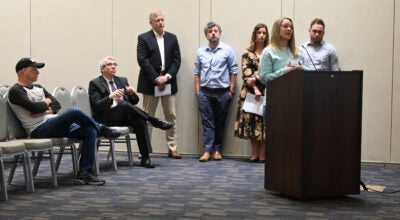Homegrown farmer: Duard Cress a fixture at local market
Published 12:00 am Tuesday, December 1, 2009
By Susan Shinn
sshinn@salisburypost.com
CHINA GROVE ó You might’ve missed that story in a recent farmers market report about Duard Cress, sleeping out in the greenhouse with snow on the ground for a few nights so he’d have homegrown tomatoes by May.
No big deal, says Cress, who at 88 is only currently bothered by a corn on his left foot.
Doesn’t slow him down much.
Cress is a fixture at the farmers market in downtown Salisbury, but he grows his fruits and vegetables on a 150-acre farm on Shue Road.
His daughter, Mary Corriher, one of his six children with wife Betty, is his partner in the venture.
During an early-morning stroll through their one-acre garden, we happen upon a list written on cardboard, stuck in a twine bag on one of the rows.
Corriher has written down what’s been planted in this patch of earth ó several varieties of tomatoes, along with butter beans, October beans, green beans, sugar snap peas, squash and cucumbers. The spring onions are gone ó they’ll plant more green beans in that spot ó and Corriher has planted a row of garbanzo beans, just to see how they’ll do.
There are Irish potatoes left to dig, and a patch of cantaloupe will be coming on in a couple of weeks. The okra is ready now.
Ask Cress how he got into farming and the answer is simple.
“That was what my family did,” he says. His father and grandfather were dairy farmers. And probably their fathers before that. The land goes back in their family to 1797.
Cress’ daddy sold milk, eggs, butter and vegetables in China Grove, hauling it by mule and buggy.
“That was way back yonder,” Cress says.
He walks through the tomatoes ó the dew is still wet on the ground ó and points out the waterlines covered by newspapers on the path.
“We didn’t need it this year,” Cress says of the irrigation system.
Tomatoes take a lot of water, but too much can cause rot. He pauses frequently to cull vegetables too close to the ground.
“It’s just now getting dry enough to get the tiller in,” he says, which Corriher attempts to do later in the morning ’til she runs out of gas.
She starts picking tomatoes to take to the farmers market later that week.
The birds are in full chorus this morning, and Cress pauses to look up at a mockingbird perched in one of the trees next to the house.
“He don’t do much damage,” says Cress, who has been known to put out apples for the birds.
Cress did have some company those freezing December nights, tending to his tiny tomato plants.
“Somebody throwed out a black tom cat,” he says. “He was a friendly cat. He was hungry and cold and stayed in there with me. I don’t know where he is now.”
For Cress’ efforts, he’s been harvesting tomatoes for the past six weeks.
Was it worth it?
“I think it was,” he says.
Cress has been growing tomatoes since he was 12 or 13. He put out 150 plants that first year.
“I had some I staked up,” he says, and his uncles ó they were Pattersons ó took them to market and got a premium price. Their tomatoes were not staked, and it made a difference.
He’s been growing tomatoes ever since.
He remembers a fishing trip in 1963, when there came a late frost. He had two acres of tomatoes.
He told his fishing buddies goodbye and left Carolina Beach, arriving home at 3 a.m.
He turned on the irrigation system, and the tomatoes were covered in ice by sun-up. The ice protected them, and he saved his crop.
“A little bit of extra time can save you,” he says. “It’s not all automatic.”
Nowadays, he covers his property by golf cart. He’s got 90-plus beef cattle on pastureland, and zips down to check on them at least once a day. They’re grazing in the pasture now, so he doesn’t need to feed them.
Cress passes a barn that was built in the ’20s. He put a new red roof on it several years ago. He wants to build some sheds around the barn to keep the hay dry, sitting now in huge round bales.
“Two years ago,” he notes, “we didn’t have any hay at all.”
He pulls into the pasture and stops. Almost immediately, the cows ó every single one of them, it seems ó surround his golf cart.
“They hear this thing coming and they think they’re going to get something to eat,” he says.
In a few minutes, Cress starts up again and the herd moves out of the way.
Cress gets into his Ford truck to go see a loblolly pine he planted on the edge of his property when he was in high school. It’s as tall as any tree on the property, and pine cones litter the ground below it.
He also wants to show off a hollow tree across the road from the house, but there’s too much thicket and poison ivy to make it through. (Tip: Don’t wear shorts when you visit a farm.)
Then it’s down to the sawmill to check out the Wood-Mizer, which can handle boards up to 36 inches wide and 21 feet long.
“We saw when we take a notion to,” Cress says. “We need to cut some.”
Behind him, large logs are piled in the field.
He eases the cart under the clothesline and returns to the tomato patch to check on his daughter.
Corriher is dressed, well, as a farm hand, every inch covered with jeans, a long-sleeved shirt, gloves and a bandanna.
Understandably, she declines to have her picture made with her father.
“I’m not out here for the looks,” she says. “The tomatoes don’t care.”
Corriher and her husband have raised two children, the younger of whom just graduated high school. She liked the flexibility that working with her father gave her.
But it’s awfully hard work, right?
Corriher agrees, but says, “I do it for Daddy.”
She adds, “You can get out a lot of tensions doing this.”
They pick in the mornings to stay out of the heat as much as they can, but Corriher has been known to till by moonlight.
The heat doesn’t seem to bother either of them.
“If you start early, you work your way into the heat,” she says.
There’s something to do every day around the farm, especially now with all the crops coming on.
“People should work in a garden for two weeks, and they would not complain about anything, would they, Daddy?” Corriher asks.
Cress just smiles.
Contact Susan Shinn at 704-797-4289 or sshinn@salisburypost.com.





